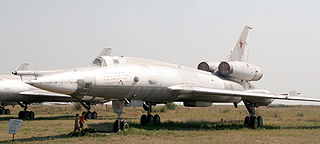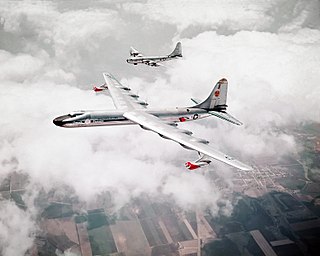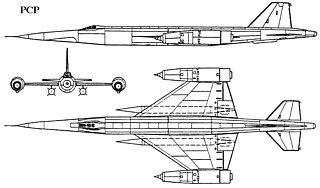Related Research Articles

The Tupolev Tu-144 is a Soviet supersonic passenger airliner designed by Tupolev in operation from 1968 to 1999.

Andrei Nikolayevich Tupolev was a Russian and later Soviet aeronautical engineer known for his pioneering aircraft designs as the director of the Tupolev Design Bureau.

A strategic bomber is a medium- to long-range penetration bomber aircraft designed to drop large amounts of air-to-ground weaponry onto a distant target for the purposes of debilitating the enemy's capacity to wage war. Unlike tactical bombers, penetrators, fighter-bombers, and attack aircraft, which are used in air interdiction operations to attack enemy combatants and military equipment, strategic bombers are designed to fly into enemy territory to destroy strategic targets. In addition to strategic bombing, strategic bombers can be used for tactical missions. There are currently only three countries that operate strategic bombers: the United States, Russia and China.

The Tupolev Tu-4 is a piston-engined Soviet strategic bomber that served the Soviet Air Force from the late 1940s to mid-1960s. The aircraft was a copy of the American Boeing B-29 Superfortress, having been reverse-engineered from seized aircraft that had made emergency landings in the USSR.

Tupolev, officially Public Joint Stock Company Tupolev, is a Russian aerospace and defence company headquartered in Basmanny District, Moscow.

The Tupolev Tu-22 was the first supersonic bomber to enter production in the Soviet Union. Manufactured by Tupolev, the Tu-22 entered service with Long-Range Aviation and Soviet Naval Aviation in the 1960s.

The Tupolev Tu-160 is a supersonic, variable-sweep wing heavy strategic bomber and airborne missile platform designed by the Tupolev Design Bureau in the Soviet Union in the 1970s. It is the largest and heaviest Mach 2+ supersonic military aircraft ever built and second to the experimental XB-70 Valkyrie in overall length and top speed. As of 2024, it is the largest and heaviest combat aircraft, the fastest bomber in use and the largest and heaviest variable-sweep wing airplane ever flown.

The Myasishchev M-4 Molot was a four-engined strategic bomber designed by Vladimir Mikhailovich Myasishchev and manufactured by the Soviet Union in the 1950s to provide a Long Range Aviation bomber capable of attacking targets in North America.

The Tupolev Tu-95 is a large, four-engine turboprop-powered strategic bomber and missile platform. First flown in 1952, the Tu-95 entered service with the Long-Range Aviation of the Soviet Air Forces in 1956 and was first used in combat in 2015. It is expected to serve the Russian Aerospace Forces until at least 2040.

The Tupolev Tu-22M is a supersonic, variable-sweep wing, long-range strategic and maritime strike bomber developed by the Tupolev Design Bureau in the 1960s. The bomber was reported as being designated Tu-26 by western intelligence at one time. During the Cold War, the Tu-22M was operated by the Soviet Air Forces (VVS) in a missile carrier strategic bombing role, and by the Soviet Naval Aviation in a long-range maritime anti-shipping role. As of 2021, there were 66 of the aircraft in service.
V. M. Myasishchev Experimental Design Bureau or OKB-23, founded in 1951 by MGB UdSSR Vladimir Myasishchev, was one of the chief Soviet aerospace design bureaus until its dissolution in 1960. Vladimir Myasishchev went on to head TsAGI. In 1967, Myasishchev left TsAGI and recreated his bureau, which still exists to this day. The bureau prefix was "M." As of 2003, its workforce is estimated at approximately one thousand. Myasishchev and NPO Molniya intend to use the V-MT or M-55 as launch vehicle for sub-orbital spaceflight.

The Myasishchev M-50 is a Soviet prototype four-jet engine supersonic strategic bomber which never attained service. Only one flightworthy prototype was built, which was first flown in October 1959. The M-50 was constructed by the Myasishchev design bureau.

A nuclear-powered aircraft is a concept for an aircraft intended to be powered by nuclear energy. The intention was to produce a jet engine that would heat compressed air with heat from fission, instead of heat from burning fuel. During the Cold War, the United States and Soviet Union researched nuclear-powered bomber aircraft, the greater endurance of which could enhance nuclear deterrence, but neither country created any such operational aircraft.

The Tupolev Tu-95LAL experimental aircraft which flew from 1961 to 1965 was a modified Tupolev Tu-95 Soviet bomber aircraft, analogous to the United States' earlier Convair NB-36H. It was intended to see whether a nuclear reactor could be used to power an aircraft, primarily testing airborne operation of a reactor and shielding for components and crew. The reactor did not actually power the aircraft.

The Tsybin RSR was a Soviet design for an advanced, long-range, Mach 3 strategic reconnaissance aircraft.
The Myasishchev M-60 was a Soviet design for a nuclear-powered bomber. The design was similar to the M-50 bomber prototype.
The Sukhoi T-60S was a planned Soviet 1980s replacement for the Tu-22M3. The supersonic intermediate range bomber never got past the drawing board. Very little information is available about technical characteristics of this aircraft, which remains classified by the Sukhoi Design Bureau. It was believed that T-60S would have featured a variable geometry wing, flat lifting fuselage and two engines, equipped with two-dimensional thrust vectoring nozzles. The armament was to include up to six Kh-101 cruise missiles, as well as AS-15 and AS-16 missiles, free-fall nuclear weapons and precision guided conventional munitions. The project was first initiated by Sukhoi in 1984 but was cancelled in the early 1990s. The bomber was to have replaced the Tu-22M in the Soviet Air Force.
The Tupolev Voron was a planned supersonic unmanned reconnaissance aircraft of the Soviet Union manufactured by the company Tupolev, largely based on or designed to compete with the Lockheed D-21.
The Tupolev Samolyot 135 was a designation that was used for two different strategic bomber projects in the Soviet Union in the late 1950s and early 1960s, neither of which progressed beyond the drawing board.
Valentin Ivanovich Bliznyuk was a Soviet and Russian aircraft designer who worked chiefly with the Tupolev design bureau over a career spanning almost seventy years.
References
- ↑ Buttler, Tony; Gordon, Yefim; Gordon, E. (2004). Soviet secret projects : bombers since 1945. Midland. pp. 149, 151. ISBN 9781857801941 . Retrieved 2024-02-25.
- ↑ Russia Air Force Handbook. USA: International Business Publications. 2007-02-07. p. 154. ISBN 9781433041150 . Retrieved 2024-02-25.
- ↑ Pike, John; Vick, Charles; Jacubowski, Mirko; Garrett, Patrick (2000-08-08). "Tu-160 BLACKJACK (TUPOLEV)". Federation of American Scientists. Maintained by Steven Aftergood. Retrieved 2024-02-25.